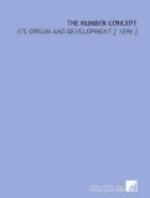1. pocchaenang. 2. haihg. 3. haigunhgnill. 4. haihgtschating. 5. haihgtschihating = another 4? 6. hathig-stchihathing = 2-4? 7. hathink-tschihathing = 2-5? 8. hathink-tschihating = 2 x 4?
The complete absence of—one is tempted to say—any rhyme or reason from this scale is more than enough to refute any argument which might tend to show that the quinary, or any other scale, was ever the sole number scale of primitive man. Irregular as this is, the system of the Montagnais fully matches it, as the subjoined numerals show:[328]
1. inl’are.
2. nak’e.
3. t’are.
4. dinri.
5. se-sunlare.
6. elkke-t’are = 2 x
3.
7. t’a-ye-oyertan = 10
— 3,
or
inl’as dinri = 4 + 3?
8. elkke-dinri = 2 x 4.
9. inl’a-ye-oyertan = 10
— 1.
10. onernan.
CHAPTER VII.
THE VIGESIMAL SYSTEM.
In its ordinary development the quinary system is almost sure to merge into either the decimal or the vigesimal system, and to form, with one or the other or both of these, a mixed system of counting. In Africa, Oceanica, and parts of North America, the union is almost always with the decimal scale; while in other parts of the world the quinary and the vigesimal systems have shown a decided affinity for each other. It is not to be understood that any geographical law of distribution has ever been observed which governs this, but merely that certain families of races have shown a preference for the one or the other method of counting. These families, disseminating their characteristics through their various branches, have produced certain groups of races which exhibit a well-marked tendency, here toward the decimal, and there toward the vigesimal form of numeration. As far as can be ascertained, the choice of the one or the other scale is determined by no external circumstances, but depends solely on the mental characteristics of the tribes themselves. Environment does not exert any appreciable influence either. Both decimal and vigesimal numeration are found indifferently in warm and in cold countries; in fruitful and in barren lands; in maritime and in inland regions; and among highly civilized or deeply degraded peoples.
Whether or not the principal number base of any tribe is to be 20 seems to depend entirely upon a single consideration; are the fingers alone used as an aid to counting, or are both fingers and toes used? If only the fingers are employed, the resulting scale must become decimal if sufficiently extended. If use is made of the toes in addition to the fingers, the outcome must inevitably be a vigesimal system. Subordinate to either one of these the quinary may and often does appear. It is never the principal base in any extended system.




